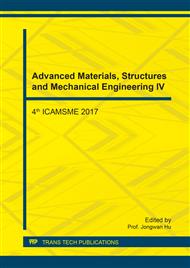[1]
NRC. Deterioration and Inspection of Water Distribution Systems, A Best Practice by the National Guide to Sustainable Municipal Infrastructure, NRC, Canada, Issue 1. 0, September (2002).
Google Scholar
[2]
F. Grablutz, S. Hanneken, Economic Modeling for Prioritizing Pipe Replacement Program, St. Louis County Water Company, USA (2000).
Google Scholar
[3]
G. Loganathan, S. Park, N. Agbenowosi, H. Sherali, A Threshold Break Rate for Scheduling Optimal Pipeline Replacement, ASCE-World Water Congress (2001).
DOI: 10.1061/40569(2001)407
Google Scholar
[4]
Y. Wang, Deterioration and Condition Rating Analysis of Water Mains, M.A.S. c. Thesis, Department of Building, Civil, and Environmental Engineering, Concordia University, Montreal, Canada (2006).
Google Scholar
[5]
H. Al Barqawi, T. Zayed, Condition Rating Models for Underground Infrastructure: Sustainable Water Mains, J. Perform. Constr. Facil. 20(2) (2006) 126-135.
DOI: 10.1061/(asce)0887-3828(2006)20:2(126)
Google Scholar
[6]
M. Fahmy, Integrated Multiple-Sensor Methodology for Condition Assessment of Water Mains, Ph.D. Thesis, Department of Building, Civil, and Environmental Engineering, Concordia University, Montreal, Canada (2010).
Google Scholar
[7]
Z. Geem, Window- Based Decision Support System for the Water Pipe Condition Assessment using Artificial Neural Network, ASCE-Conference Proceeding, World Water, and Environmental Resources Congress (2003).
DOI: 10.1061/40685(2003)147
Google Scholar
[8]
K. Shahata Y. Zayed, Simulation as a Tool for Life Cycle Cost Analysis, Proceedings of Winter Simulation Conference, pp.2497-2503, Austin, Texas, USA (2008).
DOI: 10.1109/wsc.2008.4736359
Google Scholar
[9]
A. Al-Aghbar. Automated Selection of Trenchless Technology for Rehabilitation of Water Mains, M.A. Sc. Thesis, Department of Building, Civil, and Environmental Engineering, Concordia University, Montreal, Canada (2005).
Google Scholar
[10]
R. Ramakumar, Engineering Reliability, Prentice Hall, Englewood Cliffs, New Jersey. USA (1993).
Google Scholar
[11]
K. Govil, Reliability Engineering, Tata McGraw-Hill, New Delhi, India (1983).
Google Scholar
[12]
J. Cullinane, Determining availability and reliability for water distribution systems, Reliab. Anal. Water Distribut. Syst. 1 (1989) 190-224.
Google Scholar
[13]
Y. Kleiner, B. Rajani, Forecasting variations and trends in water-main breaks, J. Infrastruct. Syst. 8(4) (2002) 122–131.
DOI: 10.1061/(asce)1076-0342(2002)8:4(122)
Google Scholar
[14]
R. Quimpo, Measure of Water Distribution System Reliability, ASCE-Risk-Based Dec. Mak. Water Res. 7 (1996) 388-395.
Google Scholar
[15]
R. Billinton, R. Allan, Reliability Evaluation of Engineering Systems, Plenum Press, NY, USA (1983).
Google Scholar
[16]
UMA Engineering Ltd. (AECOM). Water Main Management Framework: technical report, UMA Engineering Ltd. (AECOM), Mississauga, Ontario, Canada (2008).
Google Scholar
[17]
S. Miles, F. Styers, C. Nesbit, Best Results –A Case Study Using Condition and Criticality Criteria, Advances, and Experiences with Trenchless Pipeline Projects, ASCE-Pipelines (2007).
DOI: 10.1061/40934(252)72
Google Scholar
[18]
A. Salman, K. Bainbridge, K. Shahata, M. Zantingh, S. Sidawi, H. Krinas, G. Illaszewicz, J. Atherton, Risk Management Strategy for Water Distribution Networks, Ontario Water Works Association Conference, Windsor, Ontario, Canada, May 2-5 (2010).
Google Scholar
[19]
D. Backer, et al. Guidebook to Decision-Making Methods. Department of Energy, USA. (http: /emi-web. inel. gov/Nissmg/Guidebook_2002. pdf) (2001).
Google Scholar
[20]
T. L. Saaty, Decision Making for Leaders: The Analytic Hierarchy Process for Decisions in a Complex World. RWS Publications, California, USA (2001).
Google Scholar
[21]
T. Zayed, D. Halpin, Quantitative assessment for piles productivity factors. ASCE- J. Constr. Eng. Manag. 130(3) (2004) 405-414.
DOI: 10.1061/(asce)0733-9364(2004)130:3(405)
Google Scholar
[22]
T. Zayed, L. Chang, Prototype Model for Build Operate Transfer (BOT) Risk Assessment. J. Manag. Eng. ASCE, 18(1) (2002) 7-16.
DOI: 10.1061/(asce)0742-597x(2002)18:1(7)
Google Scholar
[23]
F. Lootsma, Fuzzy logic for planning and decision Making. Dordrechet, the Netherlands: Kluwer Academic Publishers (1997).
Google Scholar
[24]
T. Zayed, A. Salman, I. Basha, The Impact on Environment of Underground Infrastructure Utility Work. J. Struct. Infrastruct. Eng. UK. 7(3) (2011) 199-210.
DOI: 10.1080/15732470802445310
Google Scholar
[25]
A. Salman, T. Zayed, O. Moselhi, Reliability Assessment of Water Distribution Network, No-Dig Conference, Toronto, Canada (2009).
Google Scholar
[26]
A. Salman, Reliability-Based Management of Water Distribution Networks, Ph.D. Thesis, Department of Building, Civil, and Environmental Engineering, Concordia University, Montreal, Canada (2011).
Google Scholar
[27]
City of Hamilton website, http: /www. hamilton. ca/CityDepartments/PublicWorks/ WaterAndWasteWaterDev/, accessed on March 10th (2010).
Google Scholar


